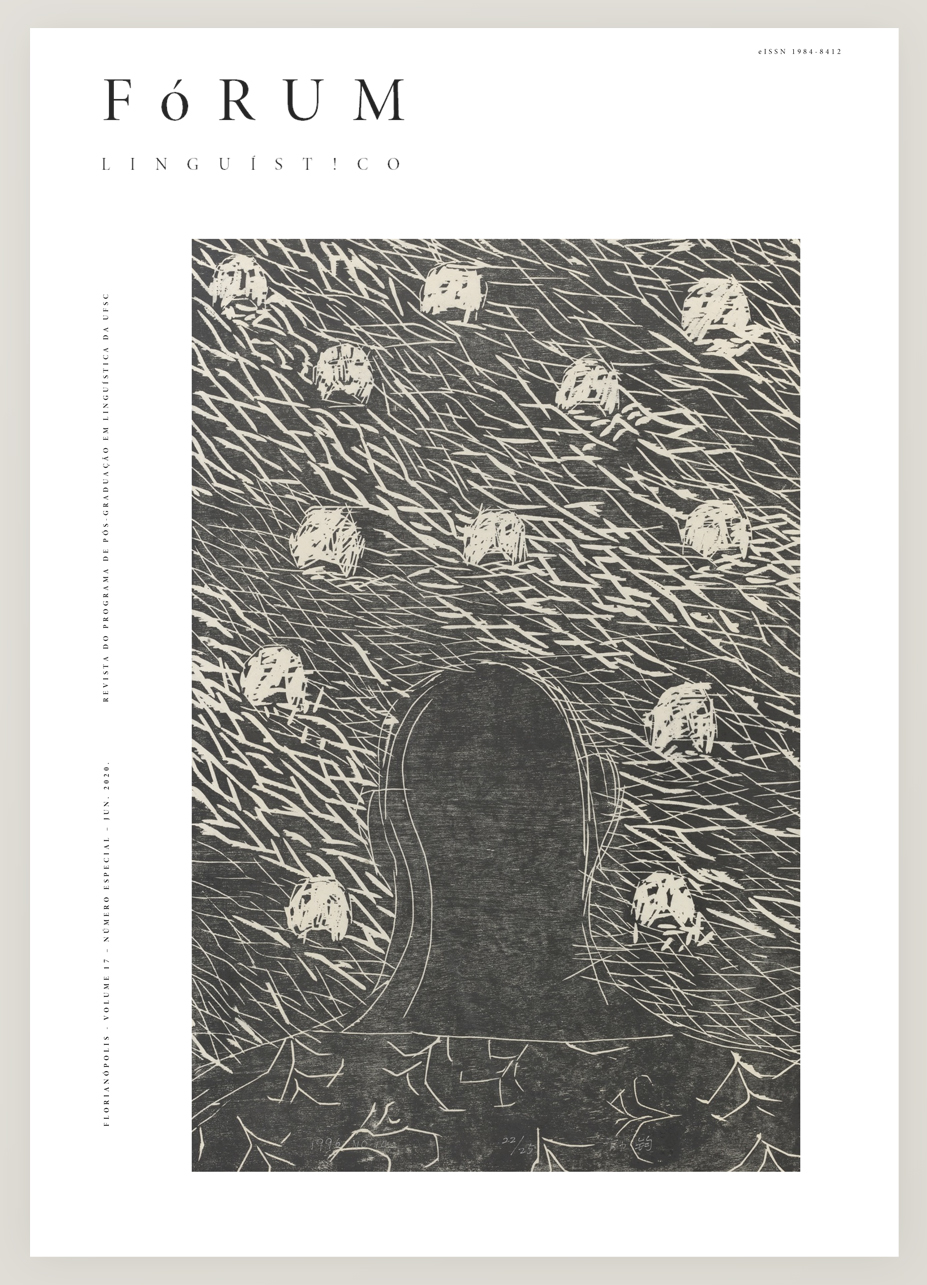Traços e classes de segmentos na arquitetura da gramática fonológica
DOI:
https://doi.org/10.5007/1984-8412.2020v17nespp4612Resumo
Com foco no papel que têm os traços na arquitetura da gramática fonológica, o estudo tem o objetivo de discutir a ação decisiva dessa unidade linguística no padrão organizacional dos segmentos em classes naturais, respondendo pela operação de processos fonológicos no funcionamento dos sistemas vocálicos e consonantais. Dados da aquisição da fonologia, particularmente do sistema consonantal do Português Brasileiro, secundados por fenômenos advindos de empréstimos linguísticos e da mudança do inventário de consonantes do Latim ao Português Contemporâneo ofereceram argumentos para a confirmação da hipótese de que determinados traços se mostram prioritariamente definidores da organização de classes naturais de segmentos na estruturação das gramáticas, seja na aquisição da linguagem pela criança, seja no funcionamento sincrônico ou diacrônico de uma língua. Alguns traços comportam-se como nucleares ou agregativos na ocupação dos espaços fonético-fonológicos, o que levou à proposição de uma Escala de Agregação, responsável pela constituição de classes de segmentos.
Referências
BERMÚDEZ-OTERO, R. Phonological change in optimality theory. In: BROWN, K. (ed.). Encyclopedia of language and linguistics, 2.ed, v.9, Oxford: Elsevier, 2006. p. 497-505.
BERMÚDEZ-OTERO, R; TROUSDALE,G. Cycles and continua: on unidirectionality and gradualness in language change. In: NEVALAINEN,T.; TRAUGOTT, E.C. (ed.). Handbook on the History of English: rethinking and extending approaches and methods. Oxford: Oxford University Press, 2012. p. 691-720.
BOERSMA, P. Cue Constraints and their interactions in phonological perception and production. Rutgers Optimality Archive 944, 2007.
BOERSMA, P. A Programme for bidirectional phonology and phonetics and their acquisition and evolution. In: BENZ, A.; MATTAUSCH, J. (ed.). Bidirectional optimality theory. Amsterdam: John Benjamins, 2011. p.33-72.
BOERSMA, P.; HAMANN, S. Loanword adaptation as first-language phonological perception. In: CALABRESE,A.; WETZELS,W.L. (ed.). Loanword phonology. Amsterdam: John Benjamins, 2009. p. 11-58.
CAMARA Jr, J. M. História e estrutura da língua portuguesa. 2. ed. Rio de Janeiro: Padrão, 1976.
CHOMSKY, N.; HALLE, M. The sound pattern of English. New York: Harper and Row. 1968.
CLEMENTS,G.N. The geometry of phonological features. Phonological Yearbook, n.2, p. 123-140, 1985.
CLEMENTS,G.N. Place of articulation in consonants and vowels: a unified theory. Working Papers of the Cornell Phonetics Laboratory, n.5, 1991.
CLEMENTS,G.N.; HUME, E.V. The internal organization of speech sounds. In: GOLDSMITH, J.(ed.). Handbook of Phonological Theory. Oxford: Blackwell, 1995. p. 245-306.
CLEMENTS,G.N. Representational economy in constraint-based phonology. In: HALL, Alan (org.). Distinctive feature theory. NewYork: Mouton de Gruyter, 2001. p. 71–146.
CLEMENTS,G.N. The Role of features in phonological inventories. In: RAIMY, E. e CAIRNS, C.E. Contemporary Views on Architecture and Representations in Phonology. Cambridge: MIT Press, 2009. p. 19-68.
DRESHER, B.E. The contrastive hierarchy in phonology. Cambridge: Cambridge University Press, 2009.
DRESHER, B.E. The motivation for contrastive feature hierarchies in phonology. Linguistic Variation. n.15, p.1-40, 2015.
DRESHER, B. E. Contrastive hierarchy theory and the nature of features. In: BENNETT,W.G.; LINDSAY HRACS,L.; STOROSHENKO,D.R. (ed.). Proceedings of the 35th West Coast Conference on Formal Linguistics, Somerville, MA: Cascadilla Proceedings Project, 2018. p.18-29.
FIKKERT, P. On the acquisition of prosodic structure. Doctoral dissertation, Holland Institute of Generative Linguistics (HIL), Leiden University. The Hague: Holland Academic Graphics, 1994.
FREITAS, M J. A aquisição da estrutura silábica do português europeu. 1997. Tese (Doutorado em Linguística) – Universidade de Lisboa, Lisboa, 1997.
GOLDSMITH, J. A. Autossegmental phonology. New York: Garland Publishing, 1976.
GUSSENHOVEN,C.; JACOBS,H. Understanding phonology. London: Arnold, 1998.
HAMMOND, M. The phonology of English: a prosodic optimality theoretic approach. Oxford: Oxford University Press, 1999.
ILARI, R. Linguística românica. 3. ed. São Paulo: Ática, 2008.
INGRAM, D. First language acquisition: method, description and explanation. Cambridge: Cambridge University Press, 1989.
JAKOBSON, R. Child language, aphasia and phonological universals. The Hague: Mouton, [1941]1968.
JAKOBSON, R.; FANT, G.; HALLE, M. Preliminaries to speech analysis. Cambridge: MIT Press. 1952.
LAMPRECHT, R.R. Perfil de aquisição normal da fonologia do português: descrição longitudinal de 12 crianças: 2:9 a 5:5. 1990. Tese (Doutorado em Linguística) – Pontifícia Universidade Católica do Rio Grande do Sul, Porto Alegre, 1990.
LAMPRECHT, R.R. et al. Aquisição Fonológica do Português. Perfil de Desenvolvimento e Subsídios para Terapia. Porto Alegre: Artes Médicas, 2004.
LAZZAROTTO-VOLCÃO, C. Modelo Padrão de Aquisição de Contrastes: uma Proposta de Avaliação e Classificação dos Desvios Fonológicos. Tese (Doutorado em Linguística) – UCPEL, Pelotas, 2009.
LEVELT, C. C. On the acquisition of a place. Doctoral Dissertation 8, Holland Institute of Generative Linguistics (HIL), Leiden University. The Hague: Holland Academic Graphics, 1994.
MATZENAUER-HERNANDORENA,C.L. Aquisição da fonologia do Português: estabelecimento de padrões com base em traços distintivos. 1990; Tese (Doutorado em Linguística) – Pontifícia Universidade Católica do Rio Grande do Sul, Porto Alegre, 1990.
MATZENAUER, C.L.B. A generalização em desvios fonológicos: o caminho pela recorrência de traços. Letras de Hoje, v. 43, n. 3, p. 27-34, jul./set. 2008.
MIRANDA, A.R.M. A aquisição do ‘r’: uma contribuição à discussão sobre seu status fonológico. 1996. Dissertação (Mestrado em Linguística) – Pontifícia Universidade Católica do Rio Grande do Sul, Porto Alegre, 1996.
NEUSCHRANK, A. Do Latim ao Português: um continuum à luz de teoria fonológica. 2011. Dissertação (Mestrado em Linguística) – Universidade Católica de Pelotas, Pelotas, 2011.
NEUSCHRANK, A. Fonologização na diacronia: do latim ao português moderno. 2015; Tese (Doutorado) – Universidade Católica de Pelotas, Pelotas, 2015.
SANTOS, R.S. A aquisição do acento primário no português brasileiro. Tese (Doutorado em Linguística) - Campinas: UNICAMP, 2001.
SILVA NETO, S. História da língua portuguesa. Rio de Janeiro: Presença, 1979.
TRUBETZKOY, N. S. Principes de phonologie. Paris: Klincksieck, 1976. [1939].
ZÁGARI, M. R. Fonologia diacrônica do português. Juiz de Fora: EDUFJF, 1988.
Downloads
Publicado
Edição
Seção
Licença
Os trabalhos publicados passam a ser de direito da Revista Fórum Linguístico, ficando sua reimpressão, total ou parcial, sujeita à autorização expressa da Comissão Editorial da revista. Deve ser consignada a fonte de publicação original.
Esta publicação está regida por uma licença Creative Commons Attribution-NonCommercial-NoDerivatives 4.0 International License.



